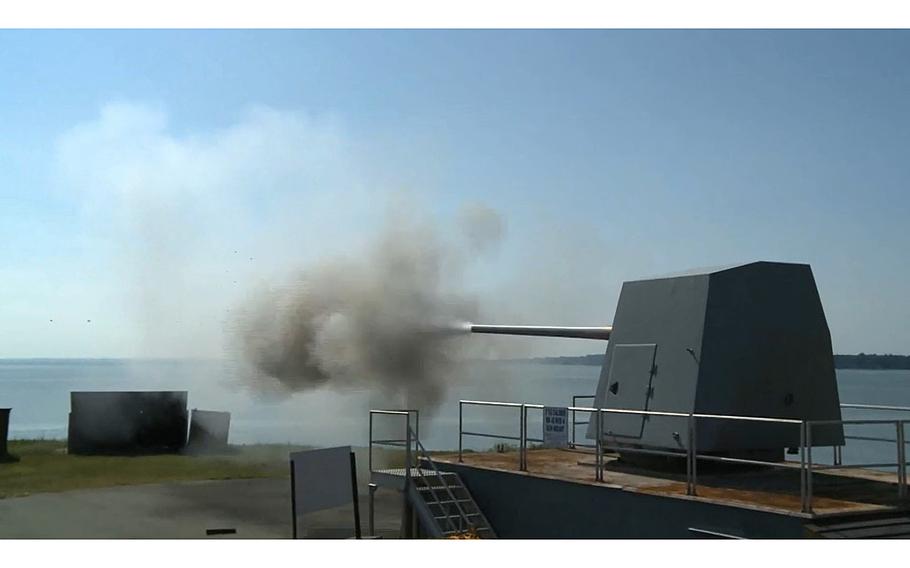
A video screen grab shows a gun weapons system firing on targets at the Naval Surface Warfare Center Dahlgren Division’s Potomac River Test Range on Aug. 30, 2016. (Stacia Courtney/U.S. Navy)
After more than a century of test-firing weapons into the lower Potomac River, the Navy this week agreed to seek a “permit for discharges of pollutants” from the state of Maryland for the Navy’s largest test-firing ground, 50 miles south of D.C.
But the Navy would not say what steps it would take to limit discharges at the site, called the Potomac River Test Range, which begins at its base in Dahlgren, Va. The range stretches 50 miles along Virginia’s Northern Neck peninsula and the tree-lined southern Maryland shores of Charles and St. Mary’s counties, with the river itself considered Maryland’s jurisdiction. The range ends where the Potomac flows into the Chesapeake Bay.
The Navy also declined to say whether it would do anything to remediate the more than 33 million pounds of ordnance it fired into the river through 2009 — including 225 tons of the toxic heavy metal manganese and 15,000 tons of iron — and the ordnance it continues to fire today.
The Navy has reported it fires about 4,700 projectiles per year into the river and conducts at least 200 detonations annually. The projectiles sometimes are fired from weapons on land and other times from barges, drones, helicopters or boats. But the most recent environmental study performed on the base’s test-firing was done in 2013, and it was based partly on statistics compiled through 2009.
Watermen have said they routinely pull large chunks of munitions, or entire missiles or rockets, out of the water near the Naval Surface Warfare Center Dahlgren Division. Huge explosions in the water are commonplace to people who live or work near the test range, which the Navy calls “the nation’s largest fully instrumented over-water gun-firing range.”
Within one 2.3-square-mile area of the testing range, called the “dense zone,” the Navy estimated that about 160,000 rounds had landed and settled on the bottom of the river through 2009, “yielding a density of 69,686 rounds per nautical square mile.”
The Navy met with conservation groups early last year but declined to provide any concrete proposals for protecting the Potomac. So the Potomac Riverkeeper Network and the Natural Resources Defense Council sued the military branch in June. To settle the lawsuit, the Navy on Wednesday signed a consent decree, approved by U.S. District Judge Deborah K. Chasanow of Maryland, requiring the Navy to apply for a “national pollutant discharge elimination system” permit within 30 days, and share the nonsensitive documents in the application with the plaintiffs.
Jay Epperson, deputy director of communications for the Maryland Department of the Environment, said the department was in communication with the Dahlgren base about applying for a permit. He said that the department would evaluate it “through the lens of applicable regulations” and that the process “will include opportunities for public participation.”
The permit could take up to two years to be issued, said Dean Naujoks, the network’s Lower Potomac riverkeeper, adding that the Department of the Environment had not evaluated dumping military munitions on a giant scale in a permit application. “This is a good first round,” Naujoks said, “but this is going to be many years in the making. We hope that [the department] establishes very protective limits for water quality and to protect users of the river.”
A Navy spokesman declined to comment on what the military would do to apply for, or comply with, a dumping permit. “Navy is aware of the consent decree and looks forward to taking the appropriate action as outlined by the court,” Lt. Cmdr. Joe Keiley said in an email.
The Navy has been testing weapons at Dahlgren since 1918, when it was called the U.S. Naval Proving Ground. Not only small- and large-caliber guns have been tested but also lasers, chemical and biological simulants and electromagnetic energy. In 2013, Navy officials produced an environmental impact statement to determine whether to expand the test-firing range. (They did expand it.)
But in addition to using old statistics on the number of projectiles in the river, the study based its environmental impact on “modeling and assumptions,” Naujoks said. “I don’t think their study is very accurate.”
The Riverkeepers are hoping the Navy is ordered to do a more complete survey of its impact on the water; on fish and other wildlife in and around it; and on the crab and oyster populations, which support numerous watermen.
“The Navy has never performed any water quality monitoring or sediment sampling, to understand the impact of its weapons testing activities on the Potomac River’s ecosystem and water quality or on public health,” the original lawsuit said.
Keiley said: “The Navy is committed to working with [Maryland environmental officials] to provide the information required to make a permit determination. The Navy’s analysis of Potomac River Test Range activities utilized the best available science, and has not identified a potential to impact human health or the environment.”